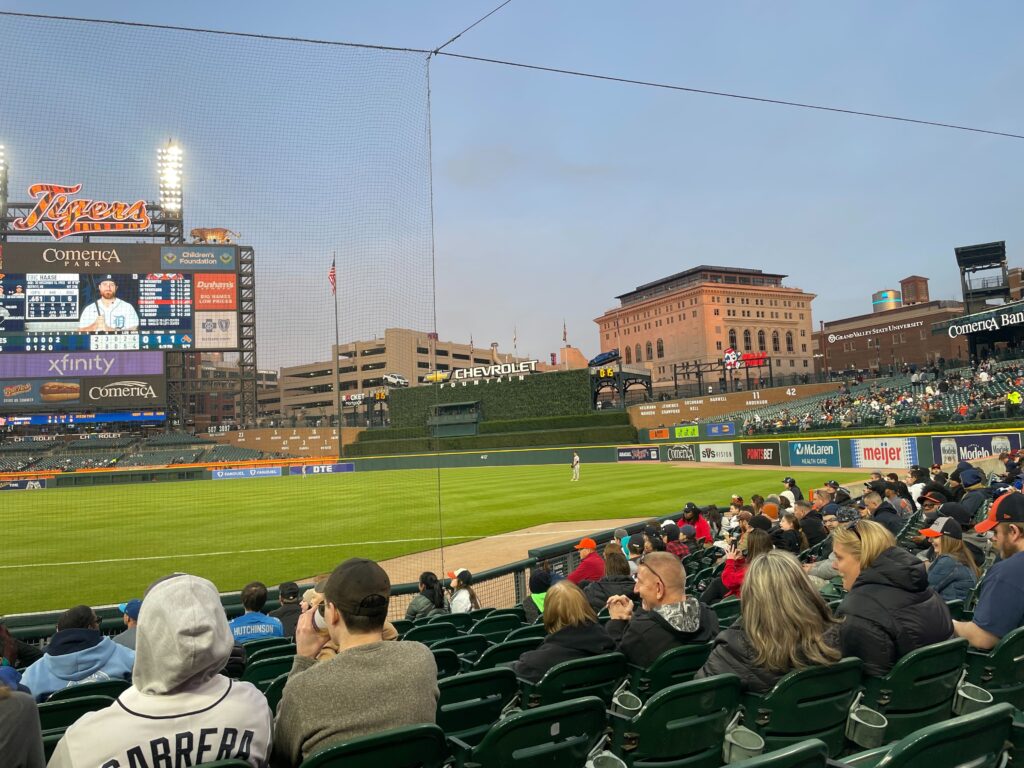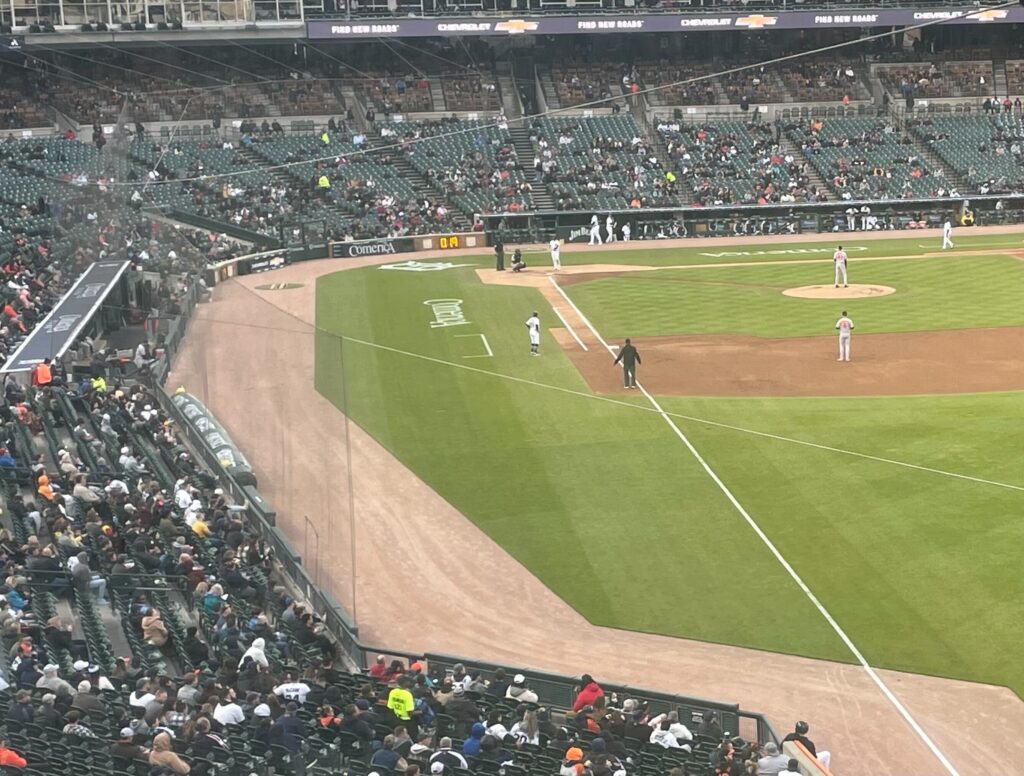Baseball is undergoing drastic change to survive the modern age. No change is bigger than the implementation of a pitch clock, giving pitchers a 15-second timer with bases empty and a 20-second timer with runners on base. Players do not only feel the impact—fan’s ballpark experience and television viewership has immensely changed.
“I love it. The game speeds up,” Justin Azar, who’s a season-ticket holder for the Detroit Tigers, mentioned. “The added suspense of a player receiving a (clock) violation is new and exciting,”
“You can’t miss the added countdown clocks around (Comerica Park’s) field—on both sides of home plate, in the outfield, just everywhere. There are moments where I find myself watching the clock anticipating a violation as opposed to the pitcher and batter.”

Photo: Blake Silverman

Photo: Blake Silverman
With shortened game times, the revenue that ballparks receive from fans in attendance has changed.
Stadiums have halted food and alcohol sales during games after the seventh inning prior to the rule change. According to a team release, the Houston Astros have already extended the time window for fans to buy food and alcoholic beverages at select locations through the end of games. At Minute Maid Park, where the Astros play their home games, 40% of locations will remain open through the end of games. The Arizona Diamondbacks, Texas Rangers, Minnesota Twins and Milwaukee Brewers have followed suit in extending the window for fans to purchase refreshments. Major League teams are analyzing their needs individually to enhance the ballpark experience as they learn from crowds shuffling through their turnstiles at a quicker cadence.
Concerns have risen that special in-game moments have not been given the proper time to breathe because of the pitch clock. Cody Bellinger, who spent six seasons with the Los Angeles Dodgers prior to signing with the Chicago Cubs this season, was called for a pitch clock violation while receiving a standing ovation during his return to Los Angeles.
The league quickly added provisions to curb similar moments from impacting box scores by allowing teams to request a stoppage in play for ovations they are expecting. But, teams must submit a request to the commissioner’s office at least 24 hours in advance if they believe one of their players may receive crowd praise. The request must then be approved by the league to avoid a potential violation call due to an ovation or similar hold up.
MLB stars have expressed frustration in adjusting to the new rule. Juan Soto, star outfielder for the San Diego Padres, has been forced to speed through his batting routine.
“There’s no time at all. You can’t even play mind games anymore,” Soto told ESPN baseball reporter Alden González.
As of May 5, there have been a total of 222 pitch timer violations recorded by pitchers, according to FanGraphs. There have also been 99 pitch timer violations by batters.
“It changed the entire game,” Detroit Tigers fan, Nathan Lelek, said. “It has to be difficult for both pitchers and batters to adjust. The players now have added pressure. Momentum can change in an instant.”
A main motivation in the addition of the pitch clock was to get more foot traffic into MLB ballparks. Last season, the league saw an average attendance of 25,217 baseball fans per game through May 4. Through the same date range, that average has increased this season to 26,256, garnering over 1,000 more fans per game since the culmination of the rule change.
Across the board, attendance numbers are rising. Looking at each team’s change in attendance helps paint a better picture. Eighteen teams have seen an increase in their average of fans in seats. The individual increases aren’t minimal, either. Of all teams with an increase in attendance, none has been less than an average of 672 fans per game. Fifteen of those 18 teams are seeing more than 1,000 supporters in their stadiums each contest.
It’s reasonable to look at whether there may be other driving forces behind fluctuations in a specific team’s attendance.
After winning the National League crown last season, prior to being defeated in the World Series by the Astros, the Philadelphia Phillies are making themselves known as a force in the Major Leagues. Philadelphia’s World Series run in 2022 was improbable, coming into the postseason as an 87-win team that got the final Wild Card spot—the last playoff ticket available. The Phillies were supposed to be an easy opponent for their foes in the National League. Then, when no one thought they could, Philly marched their way into the World Series.
Thanks to the historic run, the team was highly regarded in the offseason. Top free agent Trea Turner, a great hitter and one of the game’s best base stealers, signed with the Phillies when given the chance. Paired with Bryce Harper, a polarizing superstar, Philly is attractive enough on paper to be the best show in town.
This season, they are averaging more than 10,000 additional Phillies fans at their games each night compared to their early season games in 2022. A whopping number throughout the league.
Do quicker game speeds have an impact on the drastic variance? Most likely. But, the competitive edge that the Phillies are bringing likely has a larger say in the extreme surge.
On the other side of the spectrum, the Tigers, Colorado Rockies, and San Francisco Giants have seen the largest decrease in attendance to this point in the new season. Non-coincidentally, each of those teams were not expected to break a .500 winning percentage this season, according to Yahoo Sports and BetMGM oddsmakers. Currently, all three teams sit at least three wins below the .500 mark.
A want to drive television viewership was another guiding force in bringing modification to baseball. According to Forbes, Opening Night drew 1.5 million viewers across ESPN and ESPN2, which is an increase of 4% compared to last season. Viewership across TBS networks for their national broadcasts has risen an astonishing 69% versus last year through the season’s first two games. MLB Network primetime broadcasts are averaging 199,000 viewers, up from last year’s 192,000 average.
The league will closely watch both attendance and television viewership numbers across all teams to understand the impact of the pitch clock and other measures built to enhance the ballpark and viewing experience.
In a game where tradition and history has long been the priority, the MLB is realizing that they must cater to younger generations in order to survive. If the early numbers are any indication, league executives have found a way to accomplish their goals without compromising the sport for its long-time supporters.
Keeping an open mind to fan suggestions will pave the way for America’s pastime to prosper as its audience grows younger and younger.
“I never thought the game would change,” Azar said. “(The pitch clock) makes me excited for the future. I’m (now) counting on baseball to continue growing with their fans.”